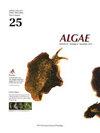隐属紫叶菊与褐叶菊的合并:分子系统发育与分类修正
IF 2.4
3区 生物学
Q1 MARINE & FRESHWATER BIOLOGY
引用次数: 1
摘要
Radicilingua Papenfuss和Calonitophyllum Aregood是delesseraceae的两个小属,分别只有三个和一个分类学上认可的物种。这些属的模式种,来自英国的Radicilingua thysanorhizans和来自美洲的Calonitophyllum medium在形态上非常相似,唯一已知的差异是脉大小和原皮发育。到目前为止,在Radicilingua属中只发现了另外两个物种:R. adriatica和R. reptans。在这项研究中,我们分析了在亚得里亚海和爱奥尼亚海(地中海)收集的Radicilingua标本,包括亚得里亚海北部的里雅斯特(Trieste)的R. adriatica模式地点,以及在英国康沃尔郡Torpoint的R. thysanorhizans模式地点附近的材料。本研究获得的rbcL-5P基因片段序列代表了第一个可用的Radicilingua属分子数据。系统发育重建表明,亚得里亚海和爱奥尼亚海的标本在遗传上不同于大西洋的thysanorhizans,即使在形态上与该物种重叠。对地中海标本的详细形态学描述以及精确的文献检索表明,它们也不同于亚得里亚卡和reptans。基于这些原因,本文描述了一种新的物种,以涵盖本研究中调查的地中海标本:r.m etalea Wolf, Sciuto & Sfriso。此外,在rbcL-5P树中,Radicilingua属和Calonitophyllum属的序列组合在一个支持良好的分支中,与Nitophylloideae亚科的其他属不同,这使我们提出Calonitophyllum的培养基应该转移到Radicilingua。本文章由计算机程序翻译,如有差异,请以英文原文为准。
Merging the cryptic genera Radicilingua and Calonitophyllum (Delesseriaceae, Rhodophyta): molecular phylogeny and taxonomic revision
Radicilingua Papenfuss and Calonitophyllum Aregood are two small genera of the family Delesseriaceae that consist of only three and one taxonomically accepted species, respectively. The type species of these genera, Radicilingua thysanorhizans from England and Calonitophyllum medium from the Americas, are morphologically very similar, with the only recognized differences being vein size and procarp development. To date, only other two species were recognized inside the genus Radicilingua: R. adriatica and R. reptans. In this study, we analysed specimens of Radicilingua collected in the Adriatic and Ionian Sea (Mediterranean), including a syntype locality of R. adriatica (Trieste, northern Adriatic Sea), alongside material from near the type locality of R. thysanorhizans (Torpoint, Cornwall, UK). The sequences of the rbcL-5P gene fragment here produced represent the first molecular data available for the genus Radicilingua. Phylogenetic reconstruction showed that the specimens from the Adriatic and Ionian Seas were genetically distinct from the Atlantic R. thysanorhizans, even if morphologically overlapping with this species. A detailed morphological description of the Mediterranean specimens, together with an accurate literature search, suggested that they were distinct also from R. adriatica and R. reptans. For these reasons, a new species was here described to encompass the Mediterranean specimens investigated in this study: R. mediterranea Wolf, Sciuto & Sfriso. Moreover, in the rbcL-5P tree, sequences of the genera Radicilingua and Calonitophyllum grouped in a well-supported clade, distinct from the other genera of the subfamily Nitophylloideae, leading us to propose that Calonitophyllum medium should be transferred to Radicilingua.
求助全文
通过发布文献求助,成功后即可免费获取论文全文。
去求助
来源期刊

Algae
PLANT SCIENCES-
CiteScore
5.10
自引率
25.00%
发文量
18
期刊介绍:
ALGAE is published by the Korean Society of Phycology and provides prompt publication of original works on phycology. ALGAE publishes articles on all aspects of phylogenetics and taxonomy, ecology and population biology, physiology and biochemistry, cell and molecular biology, and biotechnology and applied phycology. Checklists or equivalent manu-scripts may be considered for publication only if they contribute original information on taxonomy (e.g., new combinations), ecology or biogeography of more than just local relevance. Contributions may take the form of Original Research Articles, Research Notes, Review Articles and Book Reviews.
 求助内容:
求助内容: 应助结果提醒方式:
应助结果提醒方式:


